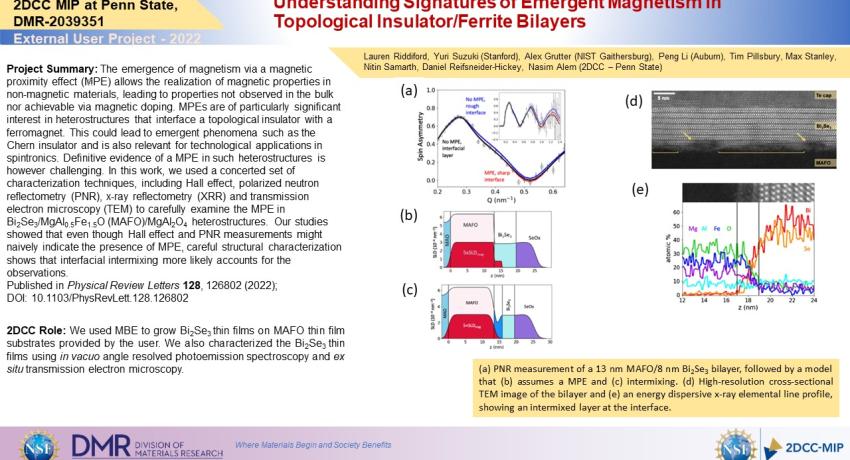Project Summary: The emergence of magnetism via a magnetic proximity effect (MPE) allows the realization of magnetic properties in non-magnetic materials, leading to properties not observed in the bulk nor achievable via magnetic doping. MPEs are of particularly significant interest in heterostructures that interface a topological insulator with a ferromagnet. This could lead to emergent phenomena such as the Chern insulator and is also relevant for technological applications in spintronics. Definitive evidence of a MPE in such heterostructures is however challenging. In this work, we used a concerted set of characterization techniques, including Hall effect, polarized neutron reflectometry (PNR), x-ray reflectometry (XRR) and transmission electron microscopy (TEM) to carefully examine the MPE in Bi2Se3/MgAl0.5Fe1.5O (MAFO)/MgAl2O4 heterostructures. Our studies showed that even though Hall effect and PNR measurements might naively indicate the presence of MPE, careful structural characterization shows that interfacial intermixing more likely accounts for the observations.
Published in Physical Review Letters 128, 126802 (2022);
DOI: 10.1103/PhysRevLett.128.126802
2DCC Role: We used MBE to grow Bi2Se3 thin films on MAFO thin film substrates provided by the user. We also characterized the Bi2Se3 thin films using in vacuo angle resolved photoemission spectroscopy and ex situ transmission electron microscopy.
What Has Been Achieved: This paper reported a careful and comprehensive study of possible magnetic proximity effect (MPE) in Bi2Se3/MgAl0.5Fe1.5O (MAFO)/MgAl2O4 heterostructures using a concerted set of characterization techniques, including Hall effect, polarized neutron reflectometry (PNR), x-ray reflectometry (XRR) and transmission electron microscopy (TEM) to carefully examine the MPE.
Importance of the Achievement: The study raised a cautionary note about the misinterpretation of PNR data to deduce the presence of PME.
Unique Feature(s) of the MIP that Enabled this Achievement: The 2DCC established the MBE growth procedures for topological insulator Bi2Se3 on MAFO. The in vacuo ARPES capability in MBE-2 was crucial for showing the Dirac surface state in the Bi2Se3 filsms. The TEM expertise within 2DCC was also crucial for drawing the main conclusion, namely that an imperfect interface can lead to a misinterpretation of PNR data in terms of a PME.
(If Applicable) Publication:
Lauren Riddiford, Alexander J. Grutter, Timothy Pillsbury, Max Stanley, Danielle Reifsnyder Hickey, Peng Li, Nasim Alem, Nitin Samarth, and Yuri Suzuki, Physical Review Letters 128, 126802 (2022); DOI: 10.1103/PhysRevLett.128.126802
Acknowledgements: This work at Stanford is supported by the Air Force Office of Scientific Research, Grant No. FA9550-20-1-0293. L. R. is supported by a NSF graduate research fellowship. Part of this work was performed at the Stanford Nano Shared Facilities (SNSF), supported by the National Science Foundation under Grant No. ECCS-2026822. We acknowledge the financial support of the National Science Foundation through the Penn State 2D Crystal Consortium Materials Innovation Platform (2DCC-MIP) under NSF cooperative Agreement No. DMR-2039351. D. R. H. and N. A. acknowledge support from the NSF CAREER program (DMR-1654107). TEM measurements were performed in the Materials Characterization Laboratory of the Materials Research Institute at the Pennsylvania State University. Certain trade names and company products are mentioned in the text or identified in an illustration in order to adequately specify the experimental procedure and equipment used. In no case does such identification imply recommendation or endorsement by the National Institute of Standards and Technology, nor does it imply that the products are necessarily the best available for the purpose.
